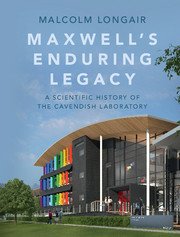Book contents
- Frontmatter
- Dedication
- Contents
- Preface
- Acknowledgements
- Part I To 1874
- Part II 1874 to 1879
- Part III 1879 to 1884
- Part IV 1884 to 1919
- Part V 1919 to 1937
- Part VI 1938 to 1953
- Part VII 1953 to 1971
- 13 The Mott era: an epoch of expansion
- 14 The Mott era: radio astronomy and high–energy physics
- 15 The Mott era: the growth of condensedmatter physics
- Part VIII 1971 to 1982
- Part IX 1984 to 1995
- Part X 1995 to present
- Appendix The evolution of the New Museums site
- Notes
- References
- Author index
- Subject index
15 - The Mott era: the growth of condensedmatter physics
from Part VII - 1953 to 1971
Published online by Cambridge University Press: 05 July 2016
- Frontmatter
- Dedication
- Contents
- Preface
- Acknowledgements
- Part I To 1874
- Part II 1874 to 1879
- Part III 1879 to 1884
- Part IV 1884 to 1919
- Part V 1919 to 1937
- Part VI 1938 to 1953
- Part VII 1953 to 1971
- 13 The Mott era: an epoch of expansion
- 14 The Mott era: radio astronomy and high–energy physics
- 15 The Mott era: the growth of condensedmatter physics
- Part VIII 1971 to 1982
- Part IX 1984 to 1995
- Part X 1995 to present
- Appendix The evolution of the New Museums site
- Notes
- References
- Author index
- Subject index
Summary
Low-temperature physics
During Mott's tenure of the Cavendish Chair, the low-temperature physics research carried out in the Mond Laboratory placed it at the forefront of the field internationally. The achievements during the Bragg era were to be reinforced by Pippard's and Shoenberg's ingenious experiments and insights into the nature of the Fermi surface, by Vinen and Hall'sdiscovery of vortex quantisation in liquid helium and by Josephson's discovery of quantum tunnelling of Cooper pairs. The vision was to carry out experiments with relatively simple apparatus but great experimental skill, very much in the Rutherford tradition.
Determination of Fermi surfaces
The Fermi surface is a theoretical three-dimensional boundary in momentum space within which the conduction electrons of a metal are contained at absolute zero. For the freeelectron model this surface is a sphere, but for a real metal the momentum states are determined by band theory, and the Fermi surface often has a remarkably complex shape, having crystal symmetry within the Brillouin zone structure of the atomic lattice, which is important in determining many of the properties of the metal (Box 15.1; see also Section 12.9.2). In the early 1950s there was no experimental determination of the shape of this surface for any metal, and band-structure calculations were not good enough to predict it reliably.
In 1954, however, Pippard showed that, in the extreme anomalous limit of the skin effect, the surface resistance provides a measure of one component of the curvature of the Fermi surface, averaged around the zone on which the electrons are moving parallel to the sample surface, and therefore ‘effective’. He concluded that it might be possible, by making sufficient observations of the surface resistance in different orientations, to determine the geometry of the Fermi surface, at least in the fairly simple case of a metal such as copper.
He carried out this programme during the academic year 1955–56, which he spent on sabbatical leave at the University of Chicago, where Morrel Cohen had arranged for the Institute for the Study of Materials to grow a very large single crystal of copper. The success of the experiment depended on cutting extremely smooth surfaces through the crystal at different angles, and this was expertly performed at the institute.
- Type
- Chapter
- Information
- Maxwell's Enduring LegacyA Scientific History of the Cavendish Laboratory, pp. 358 - 396Publisher: Cambridge University PressPrint publication year: 2016



